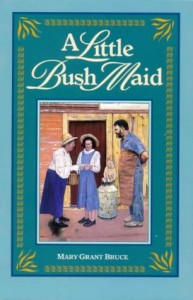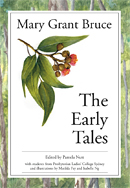by Whispering Gums
![]() An article on some of the juvenilia written by Mary Grant Bruce, the popular children’s author of the Billabong series.
An article on some of the juvenilia written by Mary Grant Bruce, the popular children’s author of the Billabong series.
_______________________________________________________________________________________
 Last month we posted on Ethel Turner’s juvenilia, drawing from the work of Juvenilia Press. The Press has also published some of the juvenilia of another popular children’s writer of the early twentieth century, Mary Grant Bruce, best known for her Billabong series (1910-1942).
Last month we posted on Ethel Turner’s juvenilia, drawing from the work of Juvenilia Press. The Press has also published some of the juvenilia of another popular children’s writer of the early twentieth century, Mary Grant Bruce, best known for her Billabong series (1910-1942).
Mary Grant Bruce was born as Minnie Grant Bruce in Gippsland, Victoria, on 24 May 1878, to an Irish-born father and an Australian-born mother of Welsh background. After finishing school, she worked as a secretary, before being employed by the Age and The Leader, and beginning her career as a journalist, short story writer, and poet.
According to Strahan, Bruce’s first recorded literary effort was “a precocious epic on an insane Czar, written at 7. Three years later she was editing her school magazine”. Strahan also says that her winning first prize in the Melbourne Shakespeare Society’s annual essay competition in April 1895, when she was still 16, brought her “more substantial literary success”. Research in Trove reveals that Bruce actively entered literary competitions through her early 20s, and was frequently placed, particularly for her essays, but also for poems and stories.
 As with Juvenilia Press’s Ethel Turner publication, their Mary Grant Bruce book, The early tales, pushes the envelope in terms of the Press’s criteria for juvenilia, which is that the works should be written when the author is 20 years old or younger. Bruce was born in 1878, and the two stories in this volume were published in 1898 (“Her little lad”) and 1900 (“Dono’s Christmas”).They were written for an adult audience when she was working for Melbourne’s The Leader newspaper.
As with Juvenilia Press’s Ethel Turner publication, their Mary Grant Bruce book, The early tales, pushes the envelope in terms of the Press’s criteria for juvenilia, which is that the works should be written when the author is 20 years old or younger. Bruce was born in 1878, and the two stories in this volume were published in 1898 (“Her little lad”) and 1900 (“Dono’s Christmas”).They were written for an adult audience when she was working for Melbourne’s The Leader newspaper.
Both stories were published as Christmas Supplements of The Leader, and both are about families. The first is a poor selector family and the second a more comfortable squatter family. However, despite their difference in means, both families experience the challenge of living isolated lives in the harsh Australian bush. Money, it seems, may provide a more comfortable house, an extra room or two, but it can’t protect you from the dangers of a life lived in isolation.
The stories belong to the tradition that includes Henry Lawson’s The drover’s wife (1892) and Barbara Baynton’s The chosen vessel (1896). In both, the father must leave his family for a day or so (wife and toddler son in “Her little lad” and wife and two young sons under ten in “Dono’s Christmas”) – and, of course, a crisis ensues that the family must cope with alone. Both stories involve snakes (as does also The drover’s wife). One also involves dangerous illness, and a child and a horse lost in a storm. In both stories, too, characters find themselves short of water. These are all common motifs in Australian bush literature. Juvenilia Press’s introduction explores them, and refers us, for example, to other works, like Banjo Paterson’s poem “Lost” and Frederick McCubbin’s painting of the same title. The lost child, and still is to a degree, a common motif in Australian literature.
With so many stories – of which the four mentioned above are just a few – dealing with such similar subject matter, it’s clear that what is being portrayed is the Australian character, and what is being developed is a sense of national identity. The introduction defines this character as comprising “independence, resourcefulness and resilience”. The fiction, poetry and art of the period portray the hardship and the failures. Citing another McCubbin painting, the introduction suggests that these works don’t idealise, but they nonetheless convey a sense of nobility. (This is a generalisation, of course. Nobility can be hard to find in many of Baynton’s stories!)
They are well-told stories that have an emotional punch alongside their historical interest. They also, as we would expect from Mary Grant Bruce, beautifully describe the bush. Here is the opening of “Her little lad”:
Across the clearing fell the first rays of the sun, each laying a path of living gold upon the long, withered grass. They lit up the giant gums, and lingered lovingly in the tangle of clematis and convolvulus which wreathed their great branches; and as they fell the night wanderers of the bush – the awkward wallaby, the giddy possum, and the shy bandicoot – started in affright and fled every one to his hole. Then the sunbeams penetrated still further, through the wild scrub tangle, down to the quiet creek, and there they lay upon its surface, forming, with the reflection of the over-hanging trees, a delicate mosaic of shadow and gold. They opened the buds of the wild orchids, the swaying bluebells, and kindled into flame the orange clusters of the grevillea; and, on the hut in the midst of the clearing, they spread curiously, as who should ask by what right man, with this ungainly excrescence, so marred the face of nature.
The introduction doesn’t discuss whether Bruce also had an environmental agenda, but she clearly recognised “man’s” impact. In “Dono’s Christmas”, we have this description of the hot Australian sun:
The sun was already up, and seemed to be climbing quickly into the cloudless sky; it was going to be a real scorcher, Dono thought, and he resolved to push on as fast as he could before the great heat commenced, when he hoped to be in the shade of the bush. So he cantered sharply over the hard-baked plain, where the sun had split big gaping fissures in the dry earth …
In an interview conducted with Mary Grant Bruce in Table Talk in 1939, Bruce is described as “an authority on Australian bush life, who talks intimately of horses, the hardships of drought conditions, country schools and bush homesteads”. Wikipedia quotes Maurice Saxby, an expert commentator on Australian Children’s Literature, as writing in 1969 that “what Ethel Turner did for the city family, Mary Grant Bruce did for the bush family.” It seems, from these early pieces, that her interest in the bush started early and remained throughout her career. It served her well.
References:
“The little pigs did it“, Table Talk, 8 June 1939
Pamela Nutt, with students from the Presbyterian Ladies College Sydney (ed). Mary Grant Bruce: The early tales. Juvenilia Press, Sydney, 2011
Lynne Strahan, ‘Bruce, Minnie Grant (Mary) (1878–1958)‘, Australian Dictionary of Biography, National Centre of Biography, Australian National University, 1979, accessed online 26 June 2022.
_______________________________________________________________________________________
Whispering Gums, aka Sue T, majored in English Literature, before completing her Graduate Diploma in Librarianship, but she spent the majority of her career as an audio-visual archivist. Taking early retirement, she engaged actively in Wikipedia, writing and editing articles about Australian women writers, before turning to litblogging in 2009. Australian women writers have been her main reading interest since the 1980s.





I love the Billabong Series. Mum had a set of the original editions. I didn’t know she wrote more…
Thanks Sara. I read my mother’s set too when I was a child… loved them too. I think most people don’t know she wrote more.
From what experience did she write? I wondered, ‘Gippsland’ covers a lot of country and starts on the outskirts of Melbourne. A search found that her grandfather was a squatter in Snowy River country in East Gippsland. How far into the Alps I’m not sure. And that MGB spent a lot of her childhood there.
But as for plains cracked by the sun, that may have been second hand.
As I said, Bill, I have a biography back in Canberra where I meant to be when I finished writing this. I will try to check it when I get home. I gave it to my mum years ago, and now I have it again.
From memory, I think MGB grew up in or around Bairnsdale.
I knew she’d written more than just the Billabong books but I had no idea about her juvenilia, Sue, so thanks for this wonderful overview.
Thanks Michelle. She was born near Sale, but I think that when she won prizes in literary competitions she was described as being from Bairnsdale.